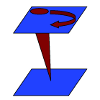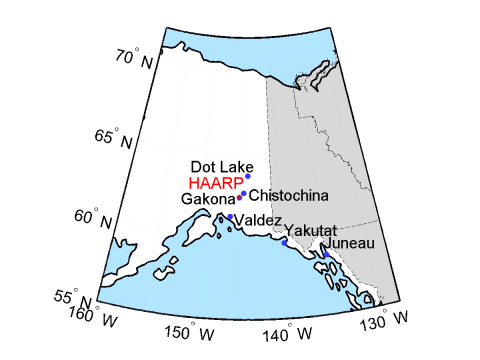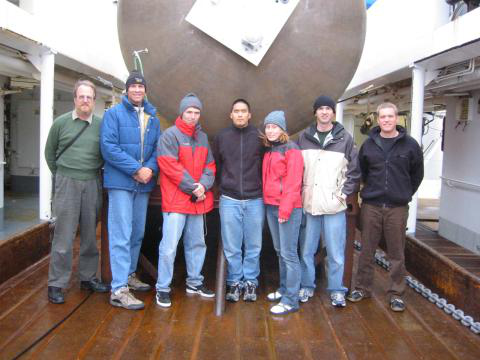Useful Links
1-minute spectrograms
from Chistochina, Alaska, updated every minute.
Online data availability
from recent and past years.
1-minute spectrograms
from Chistochina, Alaska, updated every minute.
Online data availability
from recent and past years.
Download raw and narrowband data
from Chistochina, and other Stanford ELF/VLF stations.
Introduction to HAARP
The High Frequency Active Auroral Research Program (HAARP) facility is located in Gakona, Alaska at 62.39![]()
N, 145.15![]()
W, near mile 11 of the Tok Cutoff Highway. The facility houses many diagnostic instruments for studying the ionosphere, but the highlight is the HF transmitter array. This array consists of 15×12 crossed dipole antennas, which together can transmit a total of 3600kW of RF power at frequencies from 2.8 – 10 MHz (HF, high frequency range). This power is partially absorbed by the ionosphere, and though only a tiny fraction of the power it naturally receives from the sun, can still produce subtle changes that can be detected with sensitive instruments.
The VLF group focuses on using HAARP to generate ELF and VLF waves through a process called modulated heating. Such experiments have been conducted since 1999 and include Milikh et al. (1999); Cohen et al. (2008); Rodriguez et al. (1999). HAARP is located in a region where large natural currents, known as the auroral electrojet flow through the ionosphere. By turning the HF array on and off (i.e. modulating the HF power) at ELF frequencies, we can also modulate the conductivity of the ionosphere at those frequencies (Ferraro et al., 1982; Stubbe and Kopka, 1977; Tomko et al., 1980). When combined with the electric field that drives the auroral electrojet, the result is a current that oscillates and thus radiates at the modulation frequency: a ELF antenna in the ionosphere. These signals can then be detected with nearby receivers, shown in the map in Figure 1.
VLF Science at HAARP
The VLF group is involved in several projects using HAARP that involve improving the rather poor efficiency at which HAARP is able to generate ELF waves, as well as using those ELF waves to study the ionosphere and magnetosphere. The following is a sampling of recent work in the VLF group but experiments are ongoing and new ideas are always being sought.
Geometric Modulation
Instead of modulating the power of the HF array, and thus not using it at its maximum power, geometric modulation relies on leaving the array on, but moving the beam across the sky at the ELF frequency. Figure 2 shows some examples where the beam can sweep a line or circle in the sky. Each portion of the ionosphere is effectively being heated at the ELF frequency. The heated area is larger which results in larger overall ELF power, and there is phasing between each heated region, which can impart some directionality to the radiated ELF (Cohen et al., 2008; Cohen et al., 2010).
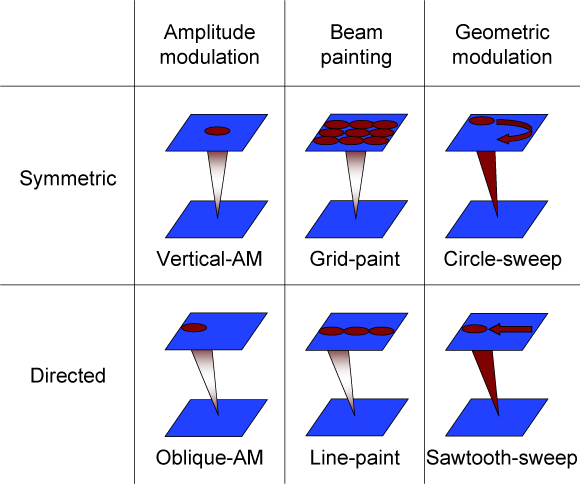
|
Magnetospheric Wave Injection
While most of the radiated ELF wave energy is confined below the ionosphere, some of it leaks out into the magnetosphere where it can be detected by satellites such as DEMETER, and under special conditions, be guided along ducts (irregularities in the plasma density) that follow the Earth’s magnetic field lines. While the waves are propagating in these ducts they are amplified by interactions with electrons in the magnetosphere. The amplified wave can then be detected in the opposite hemisphere, at the magnetic conjugate point of HAARP in the southern Pacific Ocean (Gołkowski et al., 2010; Gołkowski et al., 2008; Inan et al., 2004). The cartoon in Figure 3 illustrates this setup.
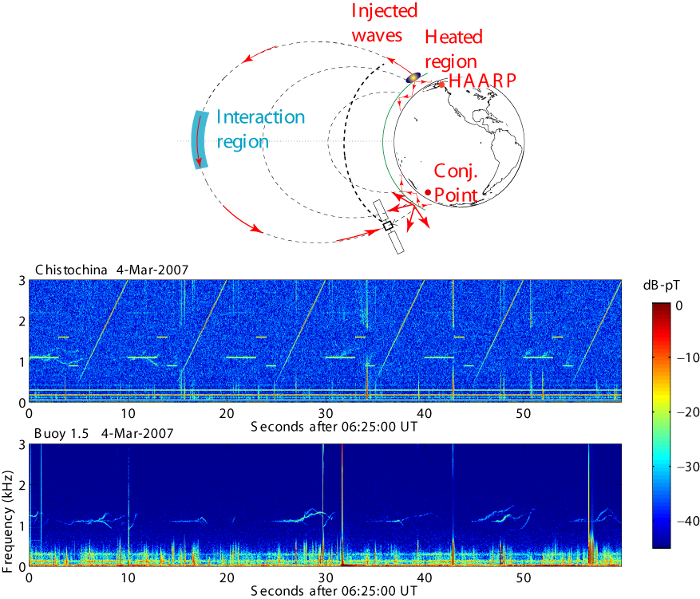
|
Stanford University previously deployed and operated two buoys containing ELF/VLF receivers which could detect these guided waves (referred to as one-hops). Though no longer functional, receivers on research vessels making crossings of the conjugate point still occasionally observe one-hops. These signals can also be reflected back along the duct and return to HAARP where it’s received as an echo that appears approximately 8 seconds after the original signal. Though obscured by the next transmitted pulse in the example in Figure 3, the-off frequency components seen rising above and below the transmitted frequency are evidence of non-linear amplification of the wave in the magnetosphere. Understanding the conditions under which these one-hops and two-hops occurs gives us a better understanding of how low-frequency waves interact with particles trapped in the magnetosphere.
Electrojet Dependence
A disadvantage of using HAARP instead of conventional ELF/VLF transmitters is HAARP’s dependence on the auroral electrojet, which naturally varies in intensity and can cause the generated ELF to also vary in intensity. However, the correlation is not direct, and surprisingly strong ELF signals can be detected even when the electrojet is negligible (Jin et al., 2009). Magnetometers which measure the Earth’s magnetic field and can detect disturbances caused by overhead currents are a simple proxy for electrojet intensity (Kamide et al., 1982; Wilkinson and Heavner, 2006). Figure 5 shows an example where ELF signals are strong during a weak electrojet. When the electrojet suddenly becomes much stronger, the ELF detected at Chistochina only becomes slightly stronger and at Juneau becomes somewhat weaker. Discovering how natural conditions affect HAARPs ability to generate ELF is a key for determining the practicality of using modulated heating as a ELF source, and for using modulated heating as another diagnostic tool in studying the ionosphere.
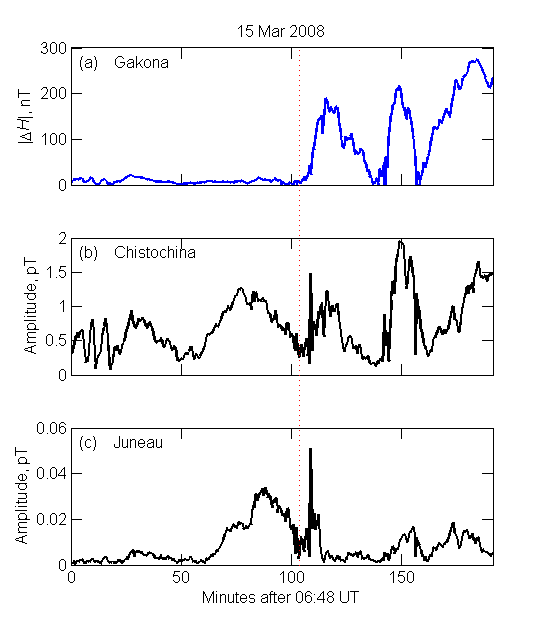
|
PARS and Student Campaigns
On alternate years the University of Alaska, Fairbanks hosts the Polar Aeronomy and Radio Science (PARS) summer school that Stanford students frequently attend. Students receive tutorial lectures on the ionosphere and magnetosphere and tours of HAARP and other facilities in Alaska such as HIPAS (a smaller ionospheric heater) and the Poker Flat Rocket Range. Each student also works with a mentor to design their own HAARP experiments and have several hours of transmission time on the array to conduct real science with this powerful tool. Activities such as a wildlife cruise in Prince William Sound are an added bonus.
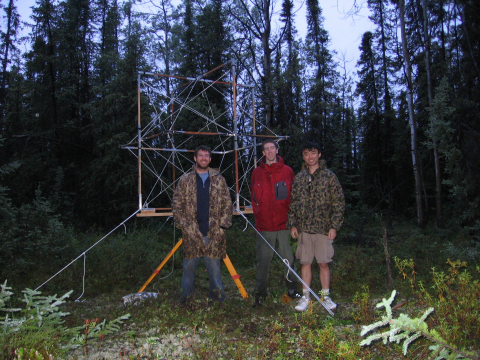
|
ELF/VLF Research at HAARP is supported by the Office of Naval Research, Air Force Research Laboratory, and Defense Advanced Projects Research Agency. Magnetometer data courtesy of the Geophysical Institute Magnetometer Array, University of Alaska, Fairbanks
Bibliography
Cohen, M. B., M. Gołkowski, and U. S. Inan (2008), Orientation of the
HAARP ELF ionospheric dipole and the auroral electrojet, Geophys.
Res. Lett., 35, 2806-+, doi:10.1029/2007GL032424.
Cohen, M. B., U. S. Inan, M. Gołkowski, and M. J. McCarrick (2010),
ELF/VLF wave generation via ionospheric HF heating: Experimental comparison
of amplitude modulation, beam painting, and geometric modulation,
Journal of Geophysical Research (Space Physics), 115(A14),
2302-+, doi:10.1029/2009JA014410.
Ferraro, A. J., H. S. Lee, R. A. Allshouse, K. Carroll, A. A. Tomko,
F. J. Kelly, and R. G. Joiner (1982), VLF/ELF radiation from the
ionospheric dynamo current system modulated by powerful HF signals,
Journal of Atmospheric and Terrestrial Physics, 44,
1113-1122.
Gołkowski, M., U. S. Inan, A. R. Gibby, and M. B. Cohen (2008),
Magnetospheric amplification and emission triggering by ELF/VLF waves
injected by the 3.6 MW HAARP ionospheric heater, Journal of
Geophysical Research (Space Physics), 113(A12), 10,201-+,
doi:10.1029/2008JA013157.
Gołkowski, M., U. S. Inan, M. B. Cohen, and A. R. Gibby (2010),
Amplitude and phase of nonlinear magnetospheric wave growth excited by the
HAARP HF heater, Journal of Geophysical Research (Space Physics),
115(A14), 0-+, doi:10.1029/2009JA014610.
Inan, U. S., et al. (2004), Multi-hop whistler-mode ELF/VLF signals and
triggered emissions excited by the HAARP HF heater, Geophys. Res.
Lett., 31, 24,805-+, doi:10.1029/2004GL021647.
Jin, G., M. Spasojevic, and U. S. Inan (2009), Relationship between
electrojet current strength and ELF signal intensity in modulated heating
experiments, Journal of Geophysical Research (Space Physics),
114(A13), 8301-+, doi:10.1029/2009JA014122.
Kamide, Y., S.-I. Akasofu, B.-H. Ahn, W. Baumjohann, and J. L.
Kisabeth (1982), Total current of the auroral electrojet estimated from
the IMS Alaska meridian chain of magnetic observatories, Planet.
Space Sci., 30, 621-625, doi:10.1016/0032-0633(82)90022-8.
Milikh, G. M., K. Papadopoulos, M. McCarrick, and J. Preston (1999),
ELF emission generated by the HAARP HF-heater using varying frequency and
polarization, Radiophysics and Quantum Electronics, 42,
639-646, doi:10.1007/BF02676849.
Rodriguez, P., et al. (1999), A wave interference experiment with HAARP,
HIPAS, and WIND, Geophys. Res. Lett., 26, 2351-2354,
doi:10.1029/1999GL900525.
Stubbe, P., and H. Kopka (1977), Modulation of polar electrojet by
powerful HF waves, J. Geophys. Res., 82, 2319-2325,
doi:10.1029/JA082i016p02319.
Tomko, A. A., A. J. Ferraro, and H. S. Lee (1980), D region absorption
effects during high-power radio wave heating, Radio Science,
15, 675-682.
Wilkinson, D., and M. J. Heavner (2006), Geophysical Institute
Magnetometer Array, AGU Fall Meeting Abstracts, pp. B1417+.
